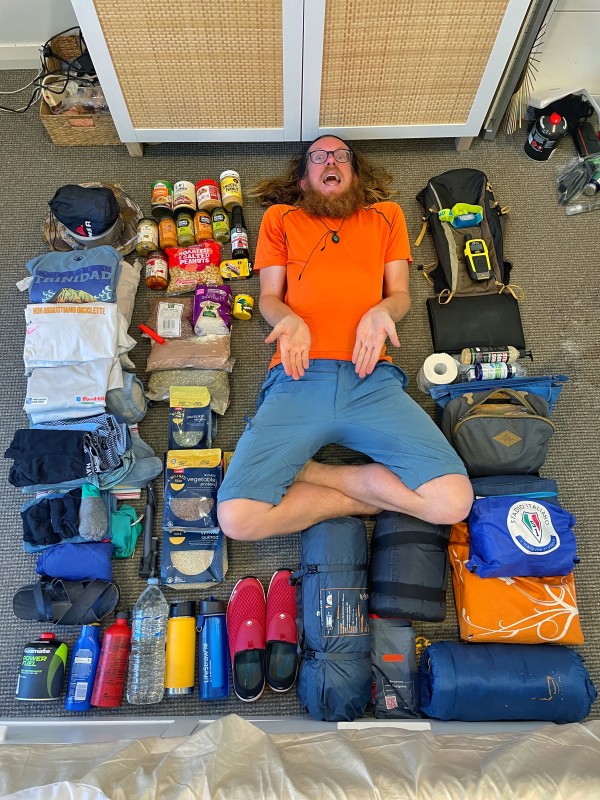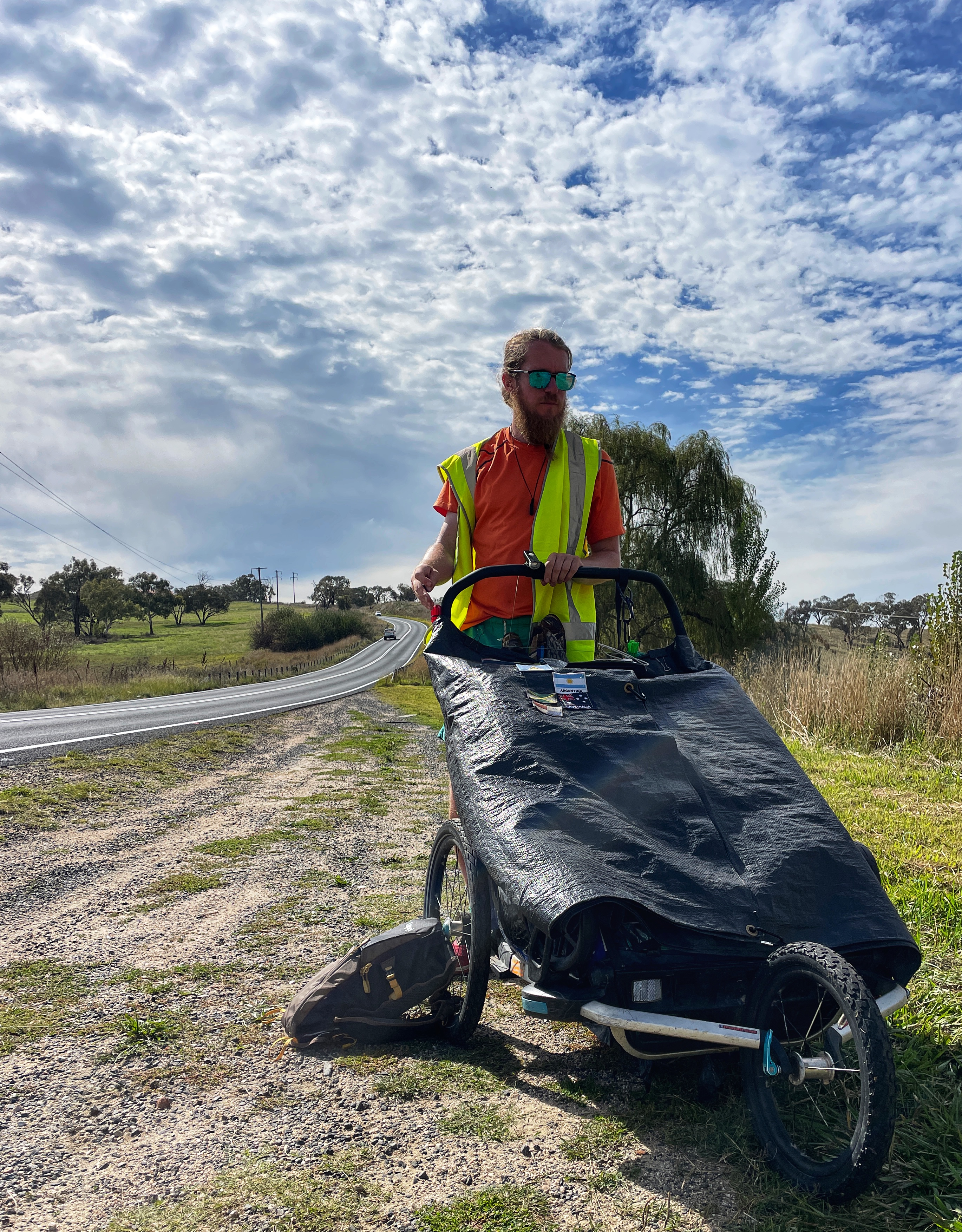
Pieroad - Outback Desert

NEW CHAPTER - PIEROAD, WALKING AROUND THE WORLD ON FOOT - AUSTRALIA
In Lyndhurst I found a place to camp, a sort of little park with clean bathrooms, electric barbecues, and even a tennis court-the rackets are in the aluminum shack that serves as a kitchen. The tent overlooks the ubiquitous eucalyptus trees that shield the playground from the noise of the road, the Mid Western Highway. The continent has changed since last time, the names are now in English, did you notice? After crossing Latin America from north to south, it is time to turn the page. The present chapter is written in red, the color of the desert that expands into the heart of this country. Have you figured out where we are? The journey continues in the land of kangaroos--Australia!

It has been almost three years since I left home in the company of Ezio, my stroller, to walk around the world. Since then we have walked thousands of miles between Europe and South America until the ground under our shoes was worn away in the Ocean. A few days ago we arrived in Australia, and after a technical stop in Sydney we set off looking westward and at the setting sun. Objective: to cross the Outback, the infamous rust-colored desert that covers eighty percent of the country's surface.
Consider that Australia alone is almost as large as Europe. Its desert is immense and second in size only to the Sahara. Five thousand kilometers and six months to cross it: the visa limit and the length of the winter season put some pressure on the walk. Unthinkable to walk it in summer; I would not be able to carry enough water.

THE OUTBACK
In order to study it better and tackle it calmly, I divided the journey into three sections: from Sydney to Adelaide, westbound; then a ninety-degree angle and route to Darwin, north end, with hundreds of kilometers in autonomy guaranteed by Ezio to arrive on the shores of the Indian Ocean. In the process, a key crossing at the center of the desert, the red center: the monolith of Uluru. It is a mountain sacred to Australian Aborigines, perhaps the most important place in their songs. I encountered it years ago while working here, and when I left I promised myself that I would come back to see it. Seven years have passed since that promise. And now, finally, it is the time to return.
Described like this, it sounds easy. The distances between outback towns, however, are considerable. Between Adelaide and Uluru it will take up to five days between resupplying, and from Uluru to Darwin the distances will stretch to 300 km and more. In some cases I will spend eight or nine days without passing through any villages. I will have to do the calculations well with water and food, and I will need plenty of protein and fat given what I will consume while walking. A few solutions are offered by dehydrated foods, which are expensive but efficient, while for fats I have only one idea in mind for the moment: butter bars. Temperatures should allow them to be carried and stored unrefrigerated.
Logistics is a difficult challenge, but it is not the only one. I will have to watch out for wild animals, especially scorpions and venomous snakes such as the infamous brown snake, with its lethal bite. Pitching the tent, removing the camp and even going to the bathroom are actions that will require an extra eye. Because it is winter, daylight hours will be few, and between June and July they will drop to just a dozen. Considering that the walk lasts 8/9 hours, there will be little time left to find a suitable place to camp and settle in before the lack of visibility makes it dangerous to venture far from the road. Concentration will be high for several months, with no real breaks to calm the nerves.

DESERT SETUP
Lyndhurst, day-8. The Manaslu 2 camps proudly on the English-cut lawn as I write crouched on an aluminum bench. This tent model has accompanied me since Peru, something like ten thousand miles ago. By now I can set it up with my eyes closed. Inside the basin lies composed a hotel room with no address. To the right, the self-inflating mattress is ready to receive me, high enough to separate my body from the ground even when I am turned on my side; the bones in my pelvis never touch the floor. A bundle of clothes serves as a pillow while the sleeping bag is open, catching air. At night I bundle up in its square, fluffy silhouette because although we are still in the countryside the daily temperature range is considerable and the nights are cool. I know I will not suffer cold in the desert; the sleeping bag is broken in from Patagonian nights in the far south of Chile and Argentina. On the opposite side of the bed are breakfast a mix of oats, cocoa and powdered milk - headlamp and a backpack of valuables, with diaries, phone and money.
Ezio sleeps outside, standing like the horses. I feel him heavy as I have only a few times, yet he only carries about fifteen kilograms between water and food. It must be the new equipment components weighing down his belly and my arms. I think back, what could it be? There is a solar charger taken especially for the desert, but it stays in the tent with me. Snake bite kit? It weighs nothing. Repair kit? Same as usual: three 16" and three 20" inner tubes, patches and rubber glue, foam for the holes, pump and those little plastic things to pop the inner tube off the wheel. Nothing new for the kitchen either. A couple of 450-gram gas canisters, a bottle of white gasoline unearthed in the paint department of a megastore, related cookware, pot and folding windshield.
Could it be the clothes? Eleven pairs of socks seem like a lot, but in the desert I will struggle to wash them and I prefer to change them every day given how much I walk - 40 km on average. Thanks to Ferrino I have a wardrobe for every eventuality. Technical jersey and light trousers for the heat, as soon as the sun starts beating down I sew the ends at the knee and they turn from shorts into long trousers. It sounds like nonsense, but this way I am protected from the sun's radiation, which is particularly aggressive in Australia. And then try sleeping without being able to remove the sticky film formed by sunscreen, dust and sweat from your skin! It's not like I can shower every day! As soon as evening falls, I wear a light jacket, and for colder nights I have a pair of trousers and a heavy jacket that also serves as a waterproof suit. With five garments I could go anywhere - and indeed I am. From the Atacama Desert to the southern tip of Patagonia, from sunny Sydney to the misty Blue Mountains, to the Outback and beyond with just two kilos of clothes. No, not even they are responsible for the fatigued shoulders.

A SMOKING MATE
I actually know the answer. The culprits are the grams, yes, the extra grams. An extra pair of socks, an extra inner tube because you never know in the desert, a water bottle that wasn't there before because with water it's better to have plenty... It's easy to gain weight, just like with a backpack. Ezio can carry up to fifty kilograms and this makes me relax so much that I put in a few more things than are strictly necessary, I know. On the other hand, I take everything with me, partly because you never know, and partly because I think a round-the-world trip on foot lasts five years and you just want to buy and leave bits and pieces on the street every time I change seasons. I put what I don't use in the lowest level of the stroller and wall it up with what I use most frequently, and at the top and in front the everyday objects and food.
I stop to reflect while sipping a piping hot mate, an heirloom from Patagonia. Extra weight too, and the half kilo of yerba mate crammed in the buggy. I smile. The mate, like a few other things on this trip, is completely useless, but maybe that is why it is one of the objects I love the most. I carry it with me because it reminds me of a wonderful time made of conversations around stoves burning wood and people who manage to take a break to savour the moment they are living. Drinking mate is like meditating, you live the here and now by patiently celebrating the ritual that is being performed. Mate is beautiful... because it is slow. This is the message I have grasped while walking for so long. Beautiful is slow.
I let out a sigh, dribble the thermos meditatively and pour some more hot water into the small yellow cup that serves as a mate, letting the trickle fall flush from the metal cannula as my friends in Chile taught me. I have a month to get to Adelaide and close the first Australian leg, the dress rehearsal for the Outback. When I arrive in the city I will still have a couple of hundred kilometres before leaving the asphalt and venturing onto the Oodnadatta track towards the heart of the desert. Two months to venture in, two more to emerge and see who comes out of the mirror. There is time, I tell myself... Enjoy this mate and get back on the road.
Share this article